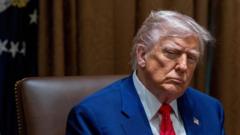After an intense week in trade discussions, President Donald Trump has suspended higher tariffs on most countries for 90 days, a move that signifies a shift in his initial plan to impose sweeping tariffs globally. This partial reversal raises questions about whether Trump is inching closer to achieving his trade ambitions.
1) **Trade Agreements**: Trump claims past nations have exploited America economically. His initial plans included a flat 10% tariff for all countries and higher tariffs targeted at 60 nations he labeled as "offenders." Now, with an ultimatum of 90 days for negotiations, allies like Japan and South Korea find themselves racing against the clock to secure better deals.
2) **American Manufacturing**: Trump believes tariffs can rejuvenate US industry. However, the unpredictable nature of his tariff decisions complicates businesses' strategic planning, making them hesitant to invest in new factories or production lines as they wait for clarity.
3) **Confrontation with China**: Trump maintains China is the main culprit in US trade woes. While he engages in a high-stakes economic showdown with the superpower, potential risks loom, particularly the alienation of necessary allies.
4) **Revenue Generation**: Trump touted that tariffs would provide a new revenue stream to alleviate the national debt. Estimates suggest a potential $2 trillion from a universal 10% tariff over the next decade. Yet, the effectiveness could hinge on how US consumers adapt to these changes.
5) **Consumer Costs**: Trump's promise of reduced prices for consumers is questioned by economists, who predict tariffs could spur price hikes, especially affecting low-income households the most. Predictions estimate a higher burden on American families, counteracting any proposed economic benefits.
As the clock ticks on these negotiations, it's clear that while Trump has stirred up conversations, the long-term success of these trade tactics remains uncertain.
1) **Trade Agreements**: Trump claims past nations have exploited America economically. His initial plans included a flat 10% tariff for all countries and higher tariffs targeted at 60 nations he labeled as "offenders." Now, with an ultimatum of 90 days for negotiations, allies like Japan and South Korea find themselves racing against the clock to secure better deals.
2) **American Manufacturing**: Trump believes tariffs can rejuvenate US industry. However, the unpredictable nature of his tariff decisions complicates businesses' strategic planning, making them hesitant to invest in new factories or production lines as they wait for clarity.
3) **Confrontation with China**: Trump maintains China is the main culprit in US trade woes. While he engages in a high-stakes economic showdown with the superpower, potential risks loom, particularly the alienation of necessary allies.
4) **Revenue Generation**: Trump touted that tariffs would provide a new revenue stream to alleviate the national debt. Estimates suggest a potential $2 trillion from a universal 10% tariff over the next decade. Yet, the effectiveness could hinge on how US consumers adapt to these changes.
5) **Consumer Costs**: Trump's promise of reduced prices for consumers is questioned by economists, who predict tariffs could spur price hikes, especially affecting low-income households the most. Predictions estimate a higher burden on American families, counteracting any proposed economic benefits.
As the clock ticks on these negotiations, it's clear that while Trump has stirred up conversations, the long-term success of these trade tactics remains uncertain.



















